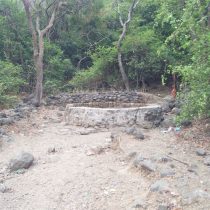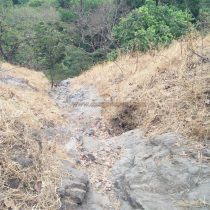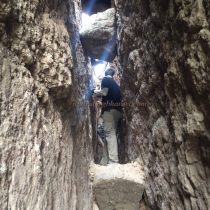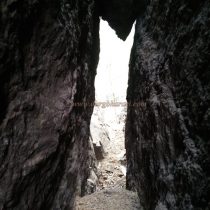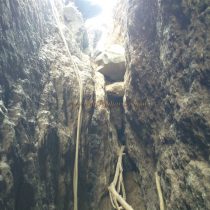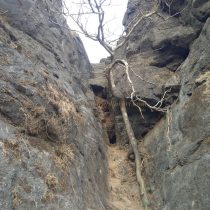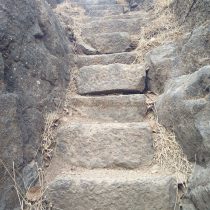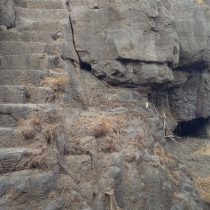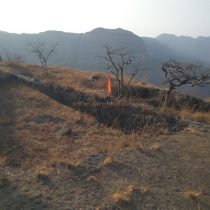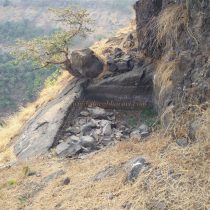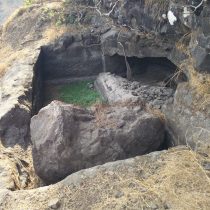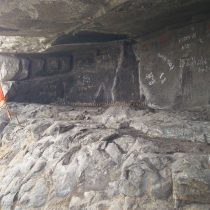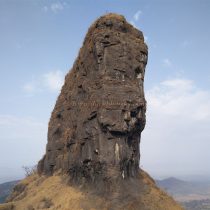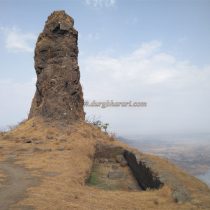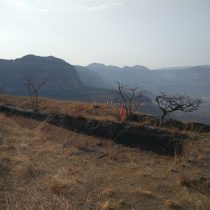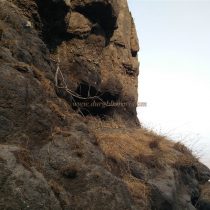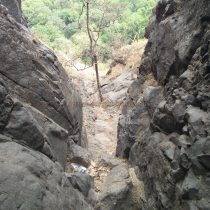PADARGAD
TYPE : HILL FORT
DISTRICT : RAIGAD
HEIGHT : 2010 FEET
GRADE : VERY HARD
Going to Bhimashankar from Ganesh Ghat via Karjat-Khandas is a favorite route of most of the trekkers. After crossing the Ganesha temple in the Ghats and coming to the plain surface, a high pinnacle constantly catches our eye on our way to Bhimashankar. As we proceed further towards this pinnacle, its shape changes into a Shivling on the top of the hill and the Nandi sitting in front of it. This hill is the Padargad fort built to keep an eye on the ancient Ganesh Ghat. The fort of Padargad must have been built because of the natural ramparts formed due to the deep ravine on its edge. The fort is difficult to reach and requires rock climbing equipment and techniques to reach it. Khandas is located at the base of the fort and is used to reach Padargad. Bhimashankar is the head of the mountain range situated at Padargad.
...
Although it is possible to reach the fort from both these places, it is more convenient to reach Padargad from Khandas. The distance between Mumbai-Karjat-Khandas is 94 km and 32 km from Karjat station. To reach Khandas village, there is an S.T. bus facility as well as private jeeps. After walking for an hour from Khandas village, we reach the Ganapati temple in Ganesh Ghat. Upon reaching the upper part of the temple, the pinnacle of Padargad begins to appear. At a turn in the road, you see a well built of stone. It takes half an hour to reach here from Ganapati temple. The well has been marked with stones and arrows and a path can be seen in front of the forest. This is the path that leads to Padargad. As there is a path leading to the fort through the gorge between Padargad and the adjoining hill, it is necessary to make sure this is the path you are proceeding on before entering the forest so that there is no possibility of getting lost. The path to Padargad is the path of flow of water down the hill through the ravine. Due to the rain, the water flowing from the mountain has carried away the soil on the road and this narrow mound has been formed and large stones are stuck in it. Therefore, the upper mouth of the gorge is closed and there is just enough space left for a person to pass through somehow. This stage has to be crossed by using mountaineering equipment and techniques more specifically by the chimney climbing technique. This is not a difficult thing for those who are experienced and visited most of the forts in Sahyadri, but new trekkers will have a difficult climbing this part and might need to use a rope. To fasten the rope a bolt has been attached on the upper side. After this comes the stage of rock climbing. Although this stage is not very difficult, it is better to put on a rope in this place for safety considering the fragile rock and the deep valley on the other side. For this, bolts are drilled into the rock. When you reach this stage, there is a steep slope in front of you. From here, we come to the gorge between the pinnacle and the fort. There are two caves carved at different angles on the hill of the fort, one of which is partially carved. This cave must have been used by guards as a porch for guarding Ganesh Ghat. There are steps carved in the rock to reach the fort from here but 5-6 steps at the beginning of the road are broken so this part has to be climbed with the help of the trees present there. As you climb these steps, you will see another cave carved in the rock on the right side. After climbing about 20-22 steps, you enter the fort. Padargad is 1974 feet above sea level. The fort is spread east and west and is divided into two parts. This fort is connected to another hill by a narrow path. In the first part, there are two water cisterns carved in the rock and there is a quadrangle structure of a building on the hill. On the other side of the head is a large but dry cistern carved into the rock. Adjacent to this cistern is a quadrangle structure of another building and on this quadrangle, there are a few stones. There are two pinnacles in this area and these pinnacles are known as the palace of Kalavantini. From here, taking a detour to the first pinnacle, we reach the gorge between the two pinnacles. Under the first pinnacle, there are two water cisterns carved in the rock towards Ganesh Ghat. The second cistern has a small cave. After seeing the cistern, come back to the gorge, from here, leaving the second pinnacle on the left, we reach the cave carved in the rock. This is the largest cave on Padargad and occasionally 8-10 people can stay in this cave but the surface of the cave is not flat. After you see the cave and come to the gorge between the pinnacles, you can see an unclear path towards the second pinnacle on the right. As proceed further on this path, it ascends to the right and heads towards the pinnacle. Since this road is very dangerous and slippery it is advisable to not go there. At the end of this path, another cistern is carved under the pinnacle. This is where your fort round ends. Although there are six cisterns in the fort, none of them consist of potable water. From Padargad you can see Bhimashankar hill to the east, Siddhagad hill to the north, and Kothligad to the south. There is a small settlement in the Ganapati Ghat which is surrounded by the fort and is known as Padargadwadi. On the southern plateau below Padargad, one can see cisterns carved in a large rock. If you start early in the morning, 4 hours are enough to walk from Khandas village to Padargad and walk around the fort. Although it is not known exactly when and where Padargad was built, its size and the above remains suggest that it has been used as a watchtower since ancient times. While conquering Kothligad, which was the arsenal of the Marathas, Aurangzeb first captured the surrounding forts, including Padargad. As the path leading to the top of Padargad is a path of flow of water, and a path that leads through the edge of the fort, a large amount of slippery algae accumulates on this road during the monsoon season and a few months after it. Therefore, avoid going to this fort during the rainy season and the two months after it. Also, since the stones on the road to the gorge are small and unstable, we tend to slip. Therefore, one should be careful while walking here. The trekkers who go to Bhimashankar use the wells under Padargad for drinking water. As there is no water facility on the fort, you have to start your trek with enough water. New trekkers should not dare to climb the fort without experienced guides and mountaineering equipment.
© Suresh Nimbalkar

